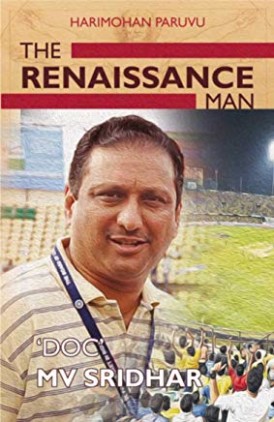The Renaissance Man
Martin Chandler |Published: 2019
Pages: 258
Author: Paravu, Harimohan
Publisher: Global News
Rating: 3.5 stars

It is by no means unknown for biographies to be written of cricketers who fall short of international recognition, particularly in England, and occasionally in Australia. It is a rare thing outside England however and, off hand, I can only think of Edwin Martin’s biography of the West Indian Jim Allen, Stranded Batsman.
Against that background I was therefore slightly nonplussed when my good friend Gulu Ezekiel asked me whether I would like a copy of this biography of MV ‘Doc’ Sridhar. Initially the name meant nothing to me, although a glance at Cricketarchive soon told me that he was a man with an impressive record. In 97 First Class matches between 1988 and 2000 Sridhar scored 6,701 runs at an average of 48.90 with a high score, still a Hyderabad record, of 366.
The Renaissance Man is not quite as good as Stranded Batsmen. Martin told the story of his friend “warts and all”, no doubt in part because it was the sort of story that demanded that. Sridhar’s biography is much more in the nature of a hagiography. It is published by Sridhar’s mother. That said she chose a professional writer and, briefly First Class cricketer, to write the book and whilst Paruvu’s agenda is clear this well written book is nonetheless an enjoyable read.
The reason for the book’s appeal is that Sridhar’s story is an interesting one quite apart from his cricket, a subject which is in the background throughout, although his First Class career actually only occupies one chapter of 19 pages.
Sridhar came from a successful family his grandfather in particular being an accomplished engineer. His grandfather’s wish was that Sridhar should become a doctor, something which he accomplished easily enough. Perhaps the time consumed by his studies held his cricket back just enough to prevent Sridhar developing into a Test player, and one of the slight frustrations of the book is it that the reasons for that failure to reach the pinnacle of the game is not really something that is explored in any detail.
After qualification as a doctor Sridhar and a friend spent a year running their own clinic before, unable to make a profit, that closed. Sridhar then left the medical profession and joined Syndicate Bank, a job that gave him the opportunity to play cricket professionally.
From banking Sridhar next became involved in the running of a college which his grandfather had been instrumental in the establishment of and from there he moved on into advertising, and then made a great success of various roles with Satyam Computers. From there he went into cricket administration and he was employed by the Hyderabad Cricket Association and the BCCI. He left his position with the board in 2017 and, tragically, a month later suffered a massive heart attack and died – he was only 51.
The key to the success of the book is the fact that author Paruvu has spoken at great length to so many people. As the sponsor of the book he has clearly had the full co-operation of Sridhar’s mother as well as his wife, children and extended family. Friends and former colleagues and teammates have also been interviewed and the reader is left with a real sense of the sort of man Sridhar was.
As indicated The Renaissance Man is something of a hagiography. The scandal that was to engulf Satyam Computers is mentioned only in passing, and there is also very little said about the cause of Sridhar’s death over and above there being some concerns about his having put on weight. Other possible contributory factors, purely rumour as far as this reviewer is concerned, are not explored at all. In a sense however those omissions matter not because it is quite clear from those who have been interviewed exactly how highly Sridhar was regarded by his peers. The foreword to the book, contributed by VVS Laxman, sets the tone and besides amounting to a ringing endorsement of Sridhar the man is also an eloquent piece of writing.
The book is well illustrated, many of the images coming from the family album of course and, in addition to the black and white photographs that appear regularly throughout the text, there is a 20 page section of colour photographs, reproduced on art paper, to close the book. A statistical summary is included as well and although there is no index there is nothing that can be seriously criticised in the production. I do not suppose that The Renaissance Man will be easily available outside of India, but I would certainly encourage anyone interested to seek out a copy.






I THINK I PLAYED CRICKET WITH HIM FOR NOTTINGHAM POLICE TRAFFIC DEPARTMENT AM I CORRECT.
Comment by MALCOLM PRICE | 1:01pm BST 17 September 2020